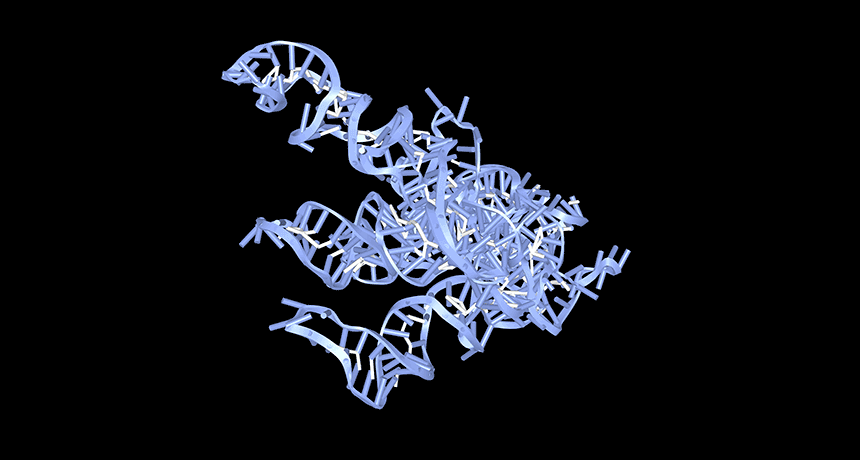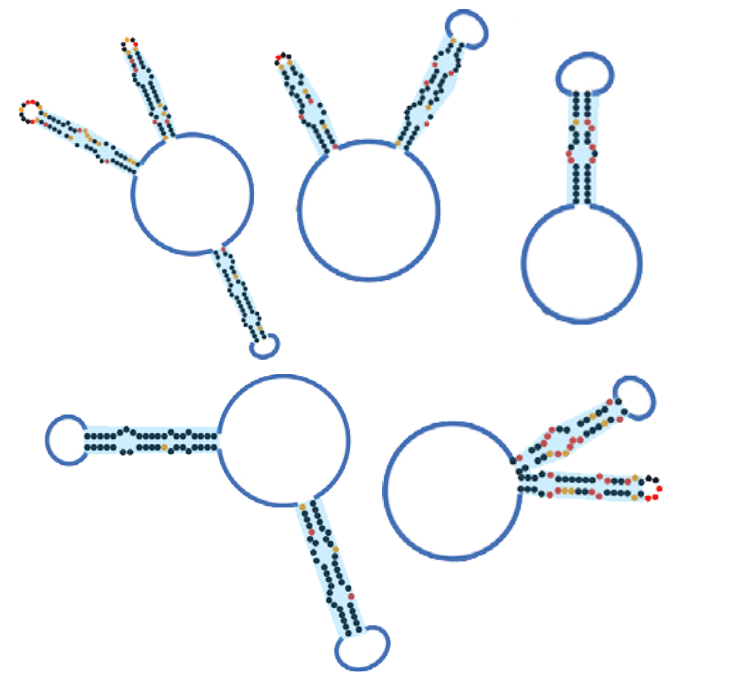A lack of circular RNAs may trigger lupus
Balancing levels of these molecules could help rein in an overactive immune system

CIRCLING LUPUS A three-dimensional image of a circular RNA reveals several places where the normally single-stranded molecule forms double strands. Those regions may be important for regulating some immune reactions.
C.-X. Liu et al/Cell 2019
A lack of certain mysterious genetic molecules may spin the immune system out of control and lead to lupus.
People with lupus have lower than normal levels of circular RNAs, triggering an immune reaction meant to fight viruses, biochemist Lingling Chen of the Shanghai Institute of Biochemistry and Cell Biology and her colleagues discovered. Switching on the body’s virus-fighting mechanisms when no harmful viruses are around may lead the immune system to attack the body. The team found that raising levels of these RNAs, known as circRNAs, in cells taken from lupus patients restored normal activity of a protein involved in rousing one arm of the immune system.
The research, reported April 25 in Cell, raises “an intriguing possibility that introduction of certain circRNAs can dampen autoimmunity associated with lupus, suggesting circular RNA as a therapeutic strategy,” says Howard Chang, a geneticist at Stanford University who was not involved in the work.
The most common type of lupus, systemic lupus erythematosus, is an autoimmune disorder in which the immune system attacks the body’s own tissues and organs. Though the exact number of people with this form of lupus isn’t known, estimates range between 161,000 and 322,000 people in the United States.
Scientists have known for decades that cells produce circular RNAs at low levels while making messenger RNAs, or mRNAs. During that process, DNA instructions in genes are copied into RNA. That initial copy contains both instructions for making a protein as well as stretches of information, called introns, which are not needed for making proteins. Cells then cut the long RNAs and splice together the protein-making instructions into mRNAs, leaving out the introns. Sometimes, introns and the other pieces of the original RNA get “back-spliced” into a closed loop of circular RNA. Circular RNAs are a type of noncoding RNA, which do not make proteins but may have other jobs (SN: 5/13/19, p. 22).
“Ever since the discovery of circular RNAs the big question is, do they do something? And if they do something, what do they do?” says Lynne Maquat, an RNA biologist and biochemist at the University of Rochester School of Medicine and Dentistry in New York. “This paper provides a compelling reason for us to think they are dampening the innate immune response.”
Innate immunity refers to a defense system provided by cells that patrol the body and kill invaders. A second line of immunity, called adaptive immunity, involves antibodies and other cells that learn which invaders are friends or foes.
Researchers generally have studied circular RNAs one at a time to learn their functions, if any, says Jørgen Kjems, a molecular biologist at Aarhus University in the Netherlands. But Chen’s team studied circular RNAs as a group, particularly ones that aren’t completely round. The team found that some normally single-stranded circular RNAs have segments that match up with other parts of the same circRNA to form double-stranded stretches. Viewed in two dimensions, the molecules look a bit like streets meeting in a traffic circle. Those roundabout circRNAs can block activity of a protein called PKR, which jump-starts innate immunity.
When a virus infects a cell, it activates a protein called RNase L that cuts up the circular RNAs, the researchers found. Without circRNAs, PKR is free to call in innate immune troops to go after the virus.
But in people with lupus, circular RNA levels are already lower than normal, so PKR activity is higher than usual. Circular RNAs with the double-stranded regions dampened PKR activity in cells taken from lupus patients. But circular RNAs that don’t contain double-stranded regions didn’t, the researchers found.
Chen’s group lacks the smoking gun proof that would conclusively link a lack of circular RNAs to lupus, Kjems says. “But this is an interesting idea that is supported by quite a lot of evidence.”







